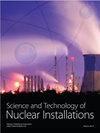incoly 800H合金在非纯氦环境中的高温腐蚀行为
IF 1
4区 工程技术
Q3 NUCLEAR SCIENCE & TECHNOLOGY
引用次数: 0
摘要
高温气冷堆(HTGR)一次回路中的氦冷却剂含有微量杂质,当暴露在高温下时,会引起高温合金的腐蚀。腐蚀引起的高温合金损伤会威胁到反应堆的安全运行。本文研究了一种具有代表性的高温合金(富铬铁基合金Incoloy 800H)在不同HTGR典型温度下的非纯氦腐蚀行为。采用研制的高温合金腐蚀实验装置,研究了incoly 800H合金的化学反应和腐蚀行为。研究发现,在与铬的反应中,CO2是重要的氧源,CO作为产物释放出来。此外,对合金中CO2与碳反应的临界温度(TC)的观测和计算表明,TC远低于小气候反应的临界温度(TA),表明CO2可以保护结垢不受破坏。此外,合金在TC以上有轻微的脱碳现象。通过热力学分析,建立了一个模型来解释轻度脱碳的机理,并预测了CO2-C反应发生时的临界温度。本文为高温高温堆中高温合金氧化垢的保护提供了指导。本文章由计算机程序翻译,如有差异,请以英文原文为准。
High-Temperature Corrosion Behavior of Incoloy 800H Alloy in the Impure Helium Environment
The helium coolant in the primary circuit of the high-temperature gas-cooled reactor (HTGR) contains traces of impurities, which can induce the corrosion of superalloys when exposed to elevated temperatures. The superalloy damage caused by the corrosion could threaten the safe operation of the reactor. In this work, the corrosion behavior of a representative superalloy (chromium-rich iron base alloy Incoloy 800H) was investigated under the impure helium at different typical temperatures of HTGR. An experimental setup developed for studying the high-temperature corrosion of superalloys was used to investigate the chemical reactions and corrosion behaviors of Incoloy 800H. It was found that CO2 is an important oxygen source in the reaction with chromium, and CO is released as the product. In addition, the observation and computation of the critical temperature (TC) of the reaction between CO2 and carbon in the alloy show that TC is much lower than that (TA) of the microclimate reaction, which indicates that CO2 can protect the scale from destruction. Furthermore, the slight decarbonization of the alloy was found above TC. Also, a model developed by the thermodynamic analysis was proposed to explain the mechanism of slight decarbonization and predict the critical temperature when the CO2-C reaction occurs. This work presents a guideline for protecting the oxide scale of superalloys used in HTGR.
求助全文
通过发布文献求助,成功后即可免费获取论文全文。
去求助
来源期刊

Science and Technology of Nuclear Installations
NUCLEAR SCIENCE & TECHNOLOGY-
CiteScore
2.30
自引率
9.10%
发文量
51
审稿时长
4-8 weeks
期刊介绍:
Science and Technology of Nuclear Installations is an international scientific journal that aims to make available knowledge on issues related to the nuclear industry and to promote development in the area of nuclear sciences and technologies. The endeavor associated with the establishment and the growth of the journal is expected to lend support to the renaissance of nuclear technology in the world and especially in those countries where nuclear programs have not yet been developed.
 求助内容:
求助内容: 应助结果提醒方式:
应助结果提醒方式:


